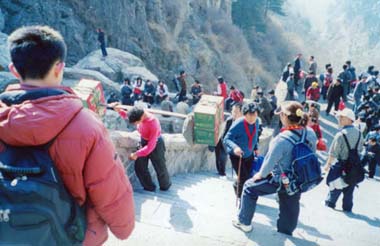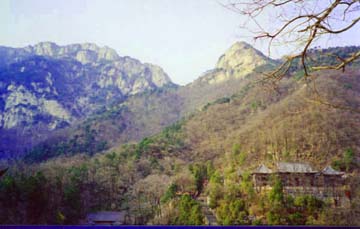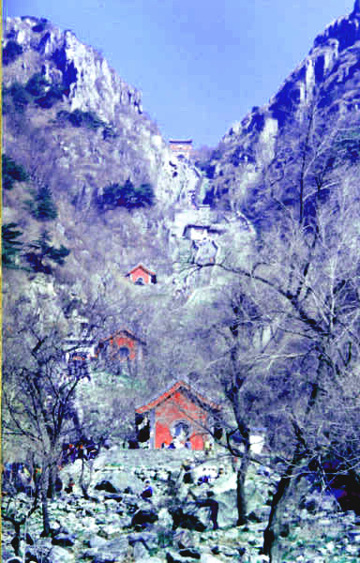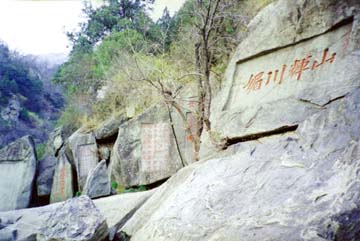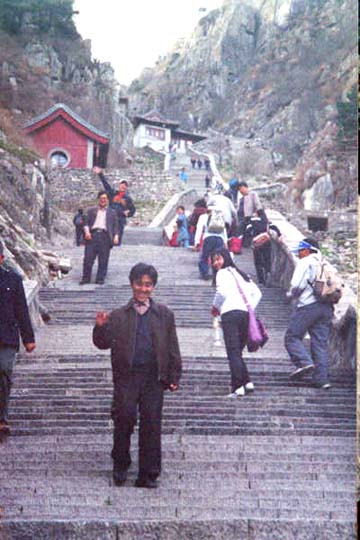|
|
China’s
Mount Tai: Where the Steps Climb Over the Sun, Tai Shan, a mountain in China’s eastern Shandong province, is the most revered of the country’s five sacred Taoist mountains. In ancient times Chinese emperors were carried by slaves up the mountain. At the summit it was their hope to offer sacrifices to heaven and earth; for an emperor to safely reach the top signified the former’s approval of his rule. Only five emperors were known to have reached the top of the 6660 steps, winding up the slopes for a total of 7.5 kilometres. When he reached the summit, the great sage and philosopher Confucius allegedly declared, “The world is small.” Upon completing his own ascent Communist Party Chairman Mao Zedong announced, “The east is red.”
I could hear a commotion further down the stairs, as one of my students pointed excitedly, motioning for me to look. Coming up the right side of the stairs was one of the famed porters of Tai Shan. For centuries the porters have carried supplies and goods up the steps literally on their backs, as there are no roads to the summit. The shops, restaurants, and few hotels have no other way of receiving their supplies. Many of the porters are continuing a family tradition practised for centuries, with some of their ancestors having been the men who carried the emperors and dignitaries to the top. The crowd of climbers behind me quickly moved to the side, getting out of the porter’s way, stopping to watch him pass. The man was about 50 years old and shirtless; his weathered skin a shining bronze that riplled with tension. Across his left shoulder was a long flat piece of wood, bending at both ends because of the weight of six cases of large glass bottles of beer, fastened three to each end. He must have been carrying 60 pounds, balanced on his shoulder like a great scale measuring the strength of his will. The man couldn’t have weighed more than 140 pounds, and stood a little over five feet. He climbed one step at a time, 6660 steps in all, 7.5 kilometres up the side of the mountain, careful to balance the weight evenly, likely wanting to climb unnoticed. He would stop for no pictures, waving the cameras away and refusing the money one of our teachers offered for his photograph. As he passed me I noticed how the frequent trips to the top, sometimes two or three times a day, had disfigured his shoulder, changing the shape of his shoulder blade into a large knot, as if on a great oak tree. He kept his eyes to the ground, carefully making one step at a time. There is a saying in China that the people of the East all walk with their heads down, walking uphill, while the people of the West walk proudly with their heads held high, unaware that they are walking downhill. There was a gondola that could have been used to carry the goods half the way up the mountain but of course the porters were cheaper, and in China, there is an endless supply of hands willing to work hard for anything they can get. Legions of poorly educated and poorly trained workers, mostly migrant farmers who enter the cities looking for jobs, can do the same work of a machine, for a fraction of the cost. This is often how the government boasts of its “perfect employment” in some regions of the country. I witnessed this circumstance at a construction site behind our school. Rather than move a huge mound of dirt in a few hours by machine, the contractor brought 12 migrant workers from the countryside, equipping them with shovels and wheelbarrows, and giving them a week to finish the job. If this kind of work isn’t finished on time, the men often don’t get paid. These farmers don’t have the money to travel back home every night, so they live onsite, in makeshift tents, wooden boards covered with a tarp held up by a salvaged pole. The men behind our school often worked well after dark without lights, as I heard them shoveling in the dark each night at 10 pm as I walked home. They made enough money to eat and send a small pittance back to their families in the countryside. Travelling through China I have noticed this phenomenon in nearly every city I visited, and was told by my students that there were millions of these migrant workers all over the country struggling to feed their families. And if they were very fortunate, they could send their children to school. The mostly male workers wait in groups near city centres, with a small sign advertising any skills they might have, in the hopes that some contractor might offer them some work. This means no unions, and definitely no benefits. Often they wait all night, and end up sleeping outside on the sidewalk, as I observed in Xian, the men patiently waiting for a better day. After taking a long rest, we made the final ascent, coming upon the South Gate to Heaven, the third and final celestial gate, after nearly six hours of climbing. Together with the two teachers with whom I had been climbing, I sprinted the final section of stairs, using whatever energy I had left, wanting to work for those last few steps to heaven. The summit of Tai Shan is a growing town of stone temples, shops, hotels and restaurants. After finding our room and enjoying an excellent dinner we sat around playing cards with the students and drinking Chinese brandy. I fell into a deep sleep that night, exhausted, but satisfied. A heavy hand knocked on our door at 4:30 am for the wake-up call. We dressed and solemnly followed our guide along a stone path leading out of the village. There was hardly enough light to see the person walking in front of me and I began to wonder if I had slept at all. The night before I thought we had reached the top of the mountain, but now we were ascending once again and I knew that even in heaven there is no end and nowhere to rest. We came to the Jade Emperor Temple built 1545 metres above sea level on the highest pinnacle of Tai Shan. In front of the temple is the Wordless Monument, a huge stone stele
erected thousands of years ago by an emperor who was dissatisfied
with what his scribes suggested as an inscription. Rather than make
his mark in words, he left the stone blank, leaving it up to the viewer’s
imagination. I walked to the edge of the promontory which was covered in a dark misty haze. We wouldn’t be able to see the sun gradually rising; it would have to split through the fog and surprise the crowd that was now gathered along the edge of the cliff. There were hundreds of people massed together between the jutting rocks, most of them young, and all turned their faces to the east. Half of them were wearing long heavy green trench coats you could rent at the top of the mountain to fight off the piercing winds. These were the old coats of the Red Army. Many of these people had slept outside, huddled together on the summit for lack of accommodations. It had been a long windy night for them and they very much needed this imminent illumination. Suddenly the crowd begin to stir. A few voices shouted out in exaltation as an orange sliver of light cut through the fog. The murmur became a cheer. Faces lit up all around me warmed by the sun and something deepr in them. The people laughed, pointed, and embraced each other as if with the relief that comes at the end of a great struggle. The sun rose as a flaming orange ball exiling the fog and pushing the shadows behind us. |
||
Landscape that Shapes Culture Tai Shan’s summit is famous all over China as a place to watch the rising and setting of the sun. According to legend, the sun begins its journey west from Mount Tai. On a clear day the coast of Shandong province, the country’s farthest eastern point, is visible 200 kilometres away. Beyond that is the Yellow Sea. A Creation Myth Mount Tai is associated with the Chinese creation myth of the trials of the giant Pan Gu. As he grew up, Pan Gu took it upon himself to divide the earth from the sky, and the taller he grew, the further they were divided. After completing the great task the giant died from exhaustion. His blood became China’s great rivers, his eyes the sun and the moon, and his limbs and head five sacred mountains of China. Tai Shan, the most celebrated of the five mountains, represents Pan Gu’s head. After some 5000 years of emperors, poets, dictators, locals and tourists struggling to reach the top, Tai Shan remains a place of pilgrimage for the Chinese, and a challenging experience for all who undertake to climb it. Having spent nearly a year working in the province of Shandong, only a day’s bus ride from the mountain, I was hardly about to miss a chance to see it for myself. A group of students and teachers at the English college where I worked had planned a trip in the middle of April, and I went along — although rather reluctantly. The reason I hesitated was that the student who organized the trip had arranged a tour for us with a Chinese tour company. I feared that I would become part of what is called “a Chinese hat tour.” This type of tour is commonly seen all over China and is not unlike other “one size fits all” group tours seen in other regions of the world. With the current surge in China’s growing market economy and
the subsequent increases in the standard of living for some Chinese,
there are more and more opportunities for them to travel abroad, increasing
the demand for tour companies specializing in “one-stop-shopping
tours” — particularly in foreign countries — to
take advantage of the volume of business that the Chinese market now
represents. Although the population is reaching out in some ways, by accepting and experiencing some aspects of foreign culture as a result of the growth of capitalism and foreign trade, China’s isolationist traditions have preserved its cultural homogeneity, largely kept in check by the Communist Party. During my two years working and traveling in China, I have observed a general sense that the Chinese are reluctant to wander off alone, to exercise spontaneity or engage in any adventurous spirit. Hence, the Chinese hat tour. These tour groups, often corralled into groups of 20 or 30, proudly wear baseball caps of the same colour so the tour guide won’t lose any of his or her flock. Not only do they all wear the same hats with the name of the tour company advertised on the front, but the hats, to keep the people visible, are often fluorescent in colour. The tour guide will rush the group around the tourist sites with a coloured flag raised in the air, so the people never get lost. To make this spectacle even more entertaining, the tour guide often has a megaphone that they use to direct the throng’s attention with harsh, crackling shouts. The student leader assured me this would not be a Chinese hat tour, although he could hardly understand why I should object to a well-organized trip. “I like to leave room for surprises,” I answered, explaining how I despised tours, whether they be in China or anywhere in the world, because I do my research before going anywhere, and I often know more than the tour guide. Secondly, it is quite frustrating to be ushered around in a tour bus according to someone else’s itinerary, with little or no freedom to stop and explore a place of one’s own choosing. There is always this arbitrary urgency to stick to the plan and fulfill a rigorous time schedule that tries to fit everything in. You usually end up rushing around from place to place without taking the time to absorb any one site, attraction, or atmosphere, while losing the opportunity to venture off the well-trodden tourist path. On top of all this, the tour usually costs more than doing it all on your own. I understand that some people are on vacation and they like having someone else do all the planning, but in my case, traveling is about independent experience, and is all the more rewarding when I arrive home feeling that I got to see and do everything I wanted without having to compromise. Surprising even myself, I put myself in the hands of the student leader organizing the trip, and agreed to the appealing itinerary of climbing the mountain in the afternoon, then spending the night in a hotel on the summit so we could wake up at dawn to view Tai Shan’s famous sunrise. Setting out Friday morning at 5 am, the eight-hour bus ride took us through the Chinese countryside. We saw how the Chinese farmers had carved the land into tiers, sculpting level growing plots out of the mountains; golden wheat fields, apple and cherry trees, spring buds blossoming in white and pink. There were no machines working the land, only a few farmers toiling away by hand. We arrived for a traditional Chinese lunch at the foot of Mount Tai in the afternoon. Taian, the small city spread around the base of the mountain, is famous for its tofu which we sampled, together with garlic stalks minced with pork, rice soup, steamed bread and a potato and chicken stew served with chicken feet and head included. After lunch we departed for the mountain, starting our climb just after 3 pm. The trail through the first gate was paved with massive grey stones. Along both sides was a lengthy series of vendors selling fake jade, hand carved walking sticks, drinks, ice cream, and a variety of other small trinkets and souvenirs. A number of vendors were selling fresh cut and delicately carved pineapple on a stick, a fruit that appears in abundance during the spring and summer months all over China. We began the ascent by walking through the Archway Under Heaven at the base of the mountain. The steps rose gradually at first, as we passed small gardens and rundown shacks across the valley. The stone walkway began to narrow and bend. Handsome stone bridges crossed the valley and rose to where the flat walkway disappeared into steps, great accordions stretching upward to peaks and plateaus where people were already beginning to stop and catch their breath. We encountered a set of temples, beginning with the Red Gate Palace, dedicated to the Princess of the Azure Clouds. The rocky headlands were dotted with old pine, cypress, and sparse dark green underbrush, nestled in the valley shade. We were losing the light quickly, and our guide informed us we likely wouldn’t make the summit before sunset, as we were slowed down by the large size of our group. I wanted to break away and ascend on my own in order to see the sunset fall below the mountain. I sought its companionship more than those panting and struggling with me, but I stayed with the group, choosing to linger and take in each step up the mountain. Our guide paused at one point to tell us the story of Zhenzong, the Emperor who had made it thus far, but was forced to dismount and be carried the rest of the way, as his horse refused to climb any further. The steps now steepened, making it clear that no large animal other than man would have been able to continue past the point where I now stood, a quarter of the total climb behind me. After nearly three hours the leaders of our group, including myself, reached the halfway point at the Midway Gate to Heaven, a cluster of small temples, lodgings, gift shops and lookout points, from where the city of Taian below us was no more, lost in the smoggy haze, thick as storm clouds. Above us I could see the mountain’s summit, though the stairs disappeared through the trees a third of the way up. We rested, enjoying a drink of water while the others gradually arrived. Once the group was collected, most of them decided they were finished, and rather than continue the ascent by foot, they chose to ride the gondola the rest of the way. My girlfriend went with them, leaving nine of us left, including the guide. The steps continued upward along the Path of Eighteen Bends, which wound its way through a valley created by tall stone embankments on both sides. The walls were decorated with hundreds of red calligraphic carvings set into the rock, composed in various figurative styles, each representing the handwriting of some famous individual. One’s writing style is traditionally regarded in China as a means of personal expression; a measure of education, sophistication, and creative skill. The carvings had been designed by famous artists, scholars, dignitaries, emperors, and revolutionaries, leaving their mark in poetry, edicts, idioms, and commentaries. The works were largely inspired by their experiences at Tai Shan and their historical perspectives, having been recorded over the thousands of years that people have been climbing the mountain. Although I could not read any of the Chinese characters, ancient or modern, the aesthetic beauty of the symbols carved into the timeless canvas of nature was not lost on me. One of my students pointed out some text written by Chairman Mao, famous for his unique and highly individualistic writing style, often abstract and unreadable for most Chinese. When will the day come when his true impact on China and its people is translated and made available to the Chinese people, without censorship or idealization? A beautifully arched stone bridge took us once again across the rocky valley to the Archway to Immortality, the final direct ascent to the summit, from where the emperors were carried on sedan chairs. We all stopped near the archway for another drink, nearly five hours into the climb. I looked down, watching some other climbers of various ages, mostly
Oriental, steadily making their way upward. One old woman carefully
used the railing to pull herself up one step at a time, followed by
a younger woman, perhaps her daughter, who tried to help her. One
of the students had a brief conversation with the younger woman, informing
me that the elderly woman was 75 years old. A number of climbers stepped
to the side, watching her in awe, smiling with respect. |
|||
